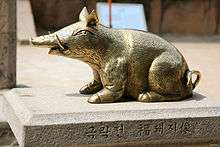Pig (zodiac)

The Pig (豬) is the twelfth and the last sign of the Earthly Branches (亥). In the continuous Sexagenary cycle, every twelfth year corresponds to Hai, and is commonly called "the Year of the Pig" (豬年). There are five types of Pigs, named after the Chinese elements. In order, they are: Metal, Water, Wood, Fire, and Earth.
In the Japanese zodiac and Tibetan zodiac, the Pig is replaced by the boar.[1] In the Dai zodiac, the Pig is replaced by the elephant.[2] In the Gurung zodiac, the Pig is replaced by the deer.[3]
Pig in the Chinese Zodiac Legend
According to the myths, the Pig was the last to arrive when the Jade Emperor called for the great meeting. Other sources said that Buddha called for a great meeting when he was about to leave the earth. The Pig came in last.
Legend has it that just as the emperor was about to call it a day, an oink and squeal was heard from a little Pig. The term "lazy Pig" is due here as the Pig got hungry during the race, promptly stopped for a feast then fell asleep. After the nap, the Pig continued the race and was named the 12th and last animal of the zodiac cycle.[4]
Other sources say that given his very stout form, he was just too slow a swimmer, and thus he could not do anything against the other animals.
Years and the Five Elements

The Pig and the Elements
The natural element of the Pig is water. Thus it is commonly associated with emotions and intuitions. Yet, given that along with the elements (also called the Celestial stem), the animal zodiac (called the earthly stem) also follows a cycle, each of the elements affect the characteristic of the same earthly stem.
However, the Pig is yin, and thus only the negative aspects of the elements can be attached to them, thus only 5 kinds of Pigs are found in the zodiac. They are the following:
- 乙亥 (yǐhài) - The Wooden Pig
- 丁亥 (dīnghài) - The Fire Pig
- 己亥 (jǐhài) - The Earthen Pig
- 辛亥 (xīnhài) - The Metal Pig
- 癸亥 (guǐhài) - The Water Pig
The Years of the Pig
People born within these date ranges can be said to have been born in the "Year of the Pig", while also bearing the following elemental sign:[5]
It should be noted that since the Chinese zodiac follows the Lunar calendar, it does not coincide with the Gregorian years or months. Thus, a person born on 9 February 1899 still belongs to the preceding zodiac (i.e. the Dog) while those born on 31 January 1900 already belongs to the following zodiac (i.e. the Rat).[6]
| Start date | End date | Heavenly Branch |
|---|---|---|
| 4 February 1815 | 23 January 1816 | Wood Pig |
| 22 January 1827 | 9 February 1828 | Fire Pig |
| 8 February 1839 | 27 January 1840 | Earth Pig |
| 27 January 1851 | 14 February 1852 | Metal Pig |
| 13 February 1863 | 1 February 1864 | Water Pig |
| 31 January 1875 | 18 February 1876 | Wood Pig |
| 18 February 1887 | 6 February 1888 | Fire Pig |
| 5 February 1899 | 24 January 1900 | Earth Pig |
| 23 January 1911 | 10 February 1912 | Metal Pig |
| 10 February 1923 | 29 January 1924 | Water Pig |
| 4 February 1935 | 23 January 1936 | Wood Pig |
| 22 January 1947 | 9 February 1948 | Fire Pig |
| 8 February 1959 | 27 January 1960 | Earth Pig |
| 27 January 1971 | 14 February 1972 | Metal Pig |
| 13 February 1983 | 1 February 1984 | Water Pig |
| 31 January 1995 | 18 February 1996 | Wood Pig |
| 18 February 2007 | 6 February 2008 | Fire Pig |
| 5 February 2019 | 24 January 2020 | Earth Pig |
| 23 January 2031 | 10 February 2032 | Metal Pig |
| 10 February 2043 | 29 January 2044 | Water Pig |
| 4 February 2055 | 23 January 2056 | Wood Pig |
| 22 January 2067 | 9 February 2068 | Fire Pig |
| 8 February 2079 | 27 January 2080 | Earth Pig |
| 27 January 2091 | 14 February 2092 | Metal Pig |
| 13 February 2103 | 1 February 2104 | Water Pig |
| 31 January 2115 | 18 February 2116 | Wood Pig |
| 18 February 2127 | 6 February 2128 | Fire Pig |
| 5 February 2139 | 24 January 2140 | Earth Pig |
| 23 January 2151 | 10 February 2152 | Metal Pig |
| 10 February 2163 | 29 January 2164 | Water Pig |
The month and hour of the Pig
Month of the Pig
Aside from being assigned a year, the Pig is also assigned to govern a month in the Lunar Calendar. As the Lunar month begins on Spring, the Pig is assigned to the 10th month, usually the time when winter begins. This lunar month corresponds to the Gregorian calendar as beginning from 7 November and ending at 6 December.
The first half of the month is called 立冬 (or in pinyin: Lìdōng). Literally, it means the "start of winter". It begins when the Sun reaches the celestial longitude of 225° and ends when it reaches the longitude of 240°. It more often refers in particular to the day when the Sun is exactly at the celestial longitude of 225°. In the Gregorian calendar, it usually begins around 7 November and ends around 22 November.
The second half of the month is called 小雪 (or in pinyin: Xiǎoxuě). Literally, the time of the "Little Snow". It begins when the Sun reaches the celestial longitude of 240° and ends when it reaches the longitude of 255°. It more often refers in particular to the day when the Sun is exactly at the celestial longitude of 240°. In the Gregorian calendar, it usually begins around 22 November and ends around 7 December.
A person born in any year is said to inherit some attributes of the Pig if they are born during these months. And thus, in order to complete the astrological reading, it is important to know this month as well.
Hour of the Pig
Given that the day is composed of 24 hours, each sign is given to the different signs of the zodiac. The Pig was assigned to govern the time between 21hrs00 to 22hrs59. According to tradition, this is the time when the Pig is doing what it does best (sleeping and enjoying the sweet life).
In terms of astrology, the hours in which the person is born (technically termed as the Ascendant) is the second most important facet of his astrology. Thus, this alters greatly the characteristics of a person. Even if a person was born in a year governed by another animal (for example someone born on 20 December 2000, i.e. Year of the Dragon) will display strong characteristics of the Pig as well. Thus he may be fierce and strong like the Dragon but at the same time emotional and intuitive like the Pig.
Relationship with other zodiacs
The Pig belongs to the 4th Trine of the Chinese zodiac, along with the Rabbit and the Goat. It is said that the relationship between these three archetypes work best as they strive for aestheticism, beauty, and a more philosophical, and intellectual approach in life. Their calm nature gives them great leadership abilities.
They are artistic, refined, intuitive, intelligent, and well-mannered. These souls love the preliminaries in love, and are fine artists in their lovemaking. The Rabbit, Goat and Pig have been bestowed with calmer natures than the other 9 signs.
These three are compassionately aware, yet detached and resigned to their condition. They seek beauty and a sensitive love. They are caring, unique, self-sacrificing, obliging, sensible, creative, empathetic, tactful, and prudent. They can also be naive, pedantic, insecure, cunning, indecisive, and pessimistic.
The Snake is said to be the most incompatible with the Pig as the jovial character of the Pig is very opposite from that of the reserved and contemplative Snake.
Chinese Zodiac Pig
| Sign | Best Match | Average | No Match |
| Pig | Pig, Rabbit, Goat | Dog, Tiger, Horse, Dragon, Monkey, Rat, Rooster, Ox | Snake |
Basic astrology elements
| Earthly Branch of Birth Year: | Hai |
| The Five Elements: | Water (Shui) |
| Yin Yang: | Yin |
| Lunar Month: | tenth |
| Lucky Numbers: | 2, 5, 6, 8; Avoid: 3, 4, 9 |
| Lucky Flowers: | lily of each and every species |
| Lucky Colors: | yellow; Avoid: red and blue |
| Season: | Winter |
Cultural notes
Some Chinese Muslims will say that they were born in the year of the hai 亥 to avoid saying Pig.[7]
See also
References
- ↑ ricardobaddouh (2014-01-28). "Tibetan Astrology – Table of Year-Animal-Element". Retrieved 2017-06-09.
- ↑ "Chinese Zodiac". Warrior Tours. Retrieved 2017-06-09.
- ↑ "Tamu (Gurung) Losar Festival". ECS Nepal. 2010-07-11. Retrieved 2017-06-09.
- ↑ Audrey Lim (2003-03-03). "Legend of the Chinese Zodiac". ThingsAsian. Retrieved 2017-06-09.
- ↑ Hesse, Annie. "Chinese Astrology: Introduction". Retrieved 17 February 2013.
- ↑ "Chinese Zodiac - Pig (Boar)". Retrieved 2017-06-09.
- ↑ Gillette, Maris Boyd (2002). Between Mecca And Beijing. Stanford: Stanford University Press. p 124. Google Book Search.
| Wikimedia Commons has media related to Pig (zodiac). |
Further reading
- Neil Somerville (2006). Your Chinese Horoscope 2007: What the Year of the Pig Holds for You. HarperCollins. p. 384. ISBN 9780007211326.
- Neil Somerville (2012). The Pig in 2013: Your Chinese Horoscope. HarperCollins. p. 80. ISBN 9780007478651.
- Neil Somerville (2013). The Pig in 2014: Your Chinese Horoscope. HarperCollins. p. 320. ISBN 9780007537044.
- Neil Somerville (2015). The Pig in 2016: Your Chinese Horoscope. HarperCollins. p. 320. ISBN 9780008138189.
- Neil Somerville (2016). The Pig in 2017: Your Chinese Horoscope. HarperCollins. p. 52. ISBN 9780008205515.
